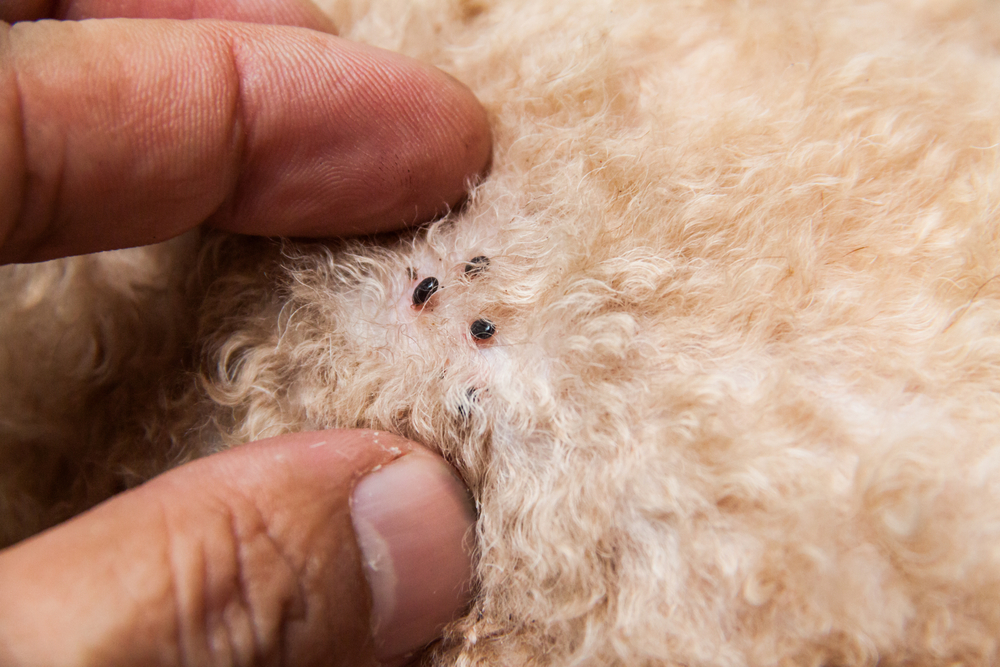For your beloved pet, external parasites such as fleas and ticks are more than an itchy nuisance. While skin disease is the most common result of flea and tick infestation, visits from these pesky parasites can cause more serious diseases, as well. You may think that the warm summer months are peak flea and tick season, but we see an increase in ticks in the fall in our area. That’s why you must remain vigilant about protecting your pet from these tiny—yet mighty—beasts. The easiest way to provide your pet with consistent parasite prevention is year-round protection.
We are not recommending that you buy extra flea and tick prevention. We are recognizing two facts:
- You have a busy life that involves more than your pets, and a monthly calendar reminder is the easiest way to remember to give your pet her potentially life-saving preventive.
- Fleas and ticks seize the moment. Their life cycles allow them to hunker down in safe spots on the coldest days, but pop out to wreak havoc when the temperature rises, if only for a few hours. Lack of year-round parasite prevention will leave your pet exposed on those oddly warm one-off winter days.
Fleas
Fleas are more than creepy—they can carry disease and cause major discomfort for your pet. An adult flea lives between four and six weeks, and during this time, a female flea can lay up to 40 eggs every day on your pet. Some eggs will drop off and hide in your carpet, furniture, and the cracks of your hardwood floors. The eggs hatch into larvae in 2 to 12 days and feed on adult flea feces.
Larvae then go through two molting processes. After the second molt, they spin a cocoon, where they live first as pupae and then develop into a flea. Eventually the flea emerges to feed on an appropriate host, like your pet, but it can lay dormant for months, waiting for the perfect opportunity, like a random, warm winter day.
Pets should be protected against fleas for these reasons:
- Flea saliva contains histamine-like substances and antigens that can irritate your pet’s skin, especially if she has a flea allergy. A single flea bite can cause generalized itchiness and skin infection in flea-allergic dogs and cats.
- Fleas carry diseases, such as cat scratch-fever and infectious anemia, that can make your pet seriously ill. Fleas can also transmit diseases to humans.
- Fleas are blood-suckers. While your large-breed dog may not miss a few drops of blood, flea-infestation of a two-pound kitten can quickly lead to anemia and death.

Ticks
Ticks are also creepy, and another menace to pets. Disease-carrying ticks have adapted to climate changes by moving to different geographic areas. We see an increased number of ticks in our area in the fall. Here are some facts about ticks and your pets:
- Ticks are parasites that inject anti-itch substances and pain-masking analgesics into their host—your pet—that allows them to remain undetected while they feed on your dog or cat. And, that’s not all—ticks also inject anticoagulants into the blood as they feed to prevent the blood from clotting.
- Ticks also inject immunomodulators to change the local immune system around their bite, which decreases host inflammation, prevents the host from recognizing the tick’s presence, and greatly increases the tick’s chances of survival. This also creates a favorable environment for the pathogens the tick is harboring and can cause Lyme disease, which affects pets and people, and other diseases that can threaten your pet’s health, including:
- Rocky Mountain spotted fever
- Anaplasmosis
- Ehrlichiosis
- Cytauxzoonosis
- Babesiosis
- Hepatozoonosis
This fall, protect your pet from parasitic illness with regular flea and tick prevention. We carry many effective products for dogs and cats, and we are happy to discuss the best options for your furry family member. If you are considering an over-the-counter flea or tick preventive, give us a call first, as some of these medications can cause illness or death if used improperly.
Still on the fence about year-round protection for your pet? Visit the Companion Animal Parasite Council’s Parasite Prevalence map to see how our neck of the woods fares in the fall with flea- and tick-borne illnesses.






Leave A Comment